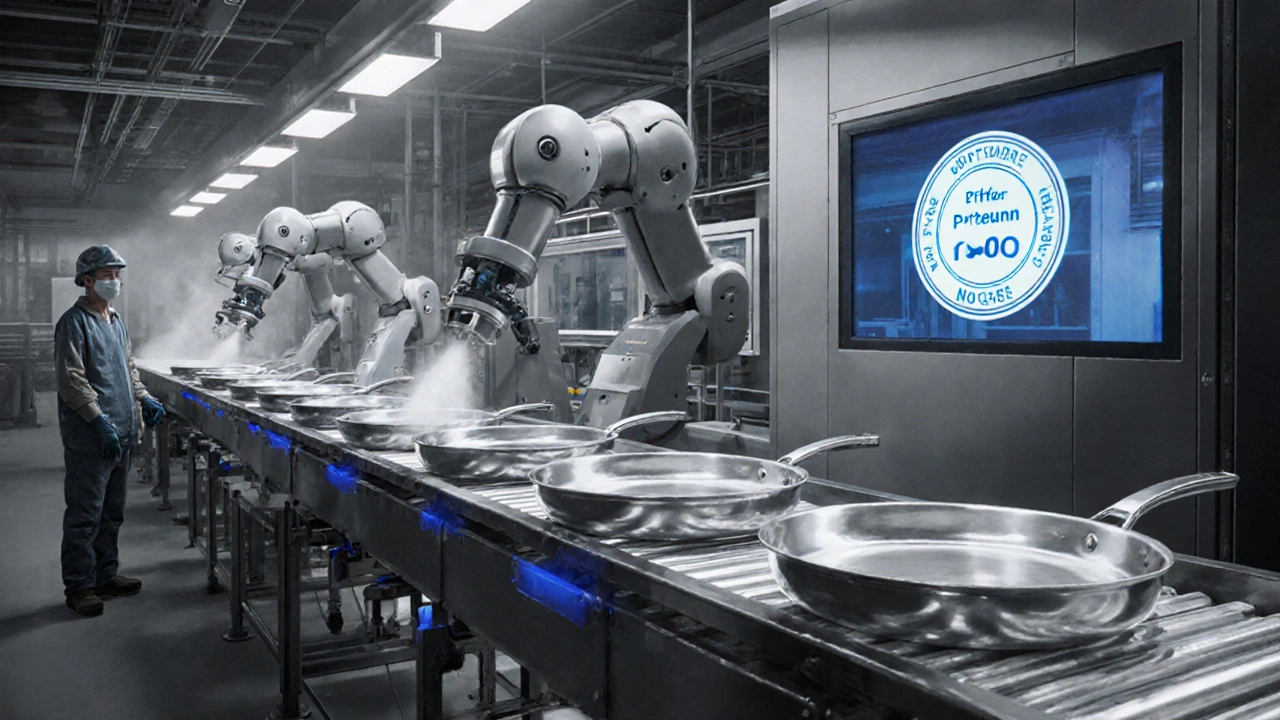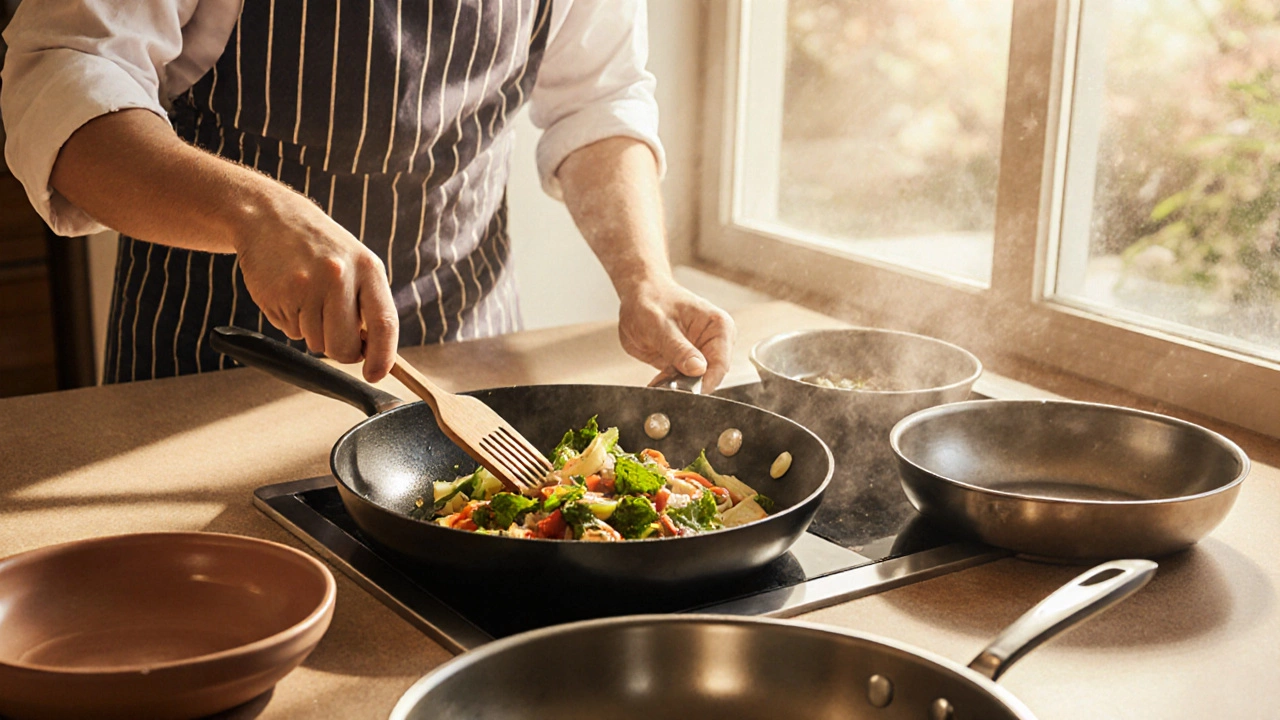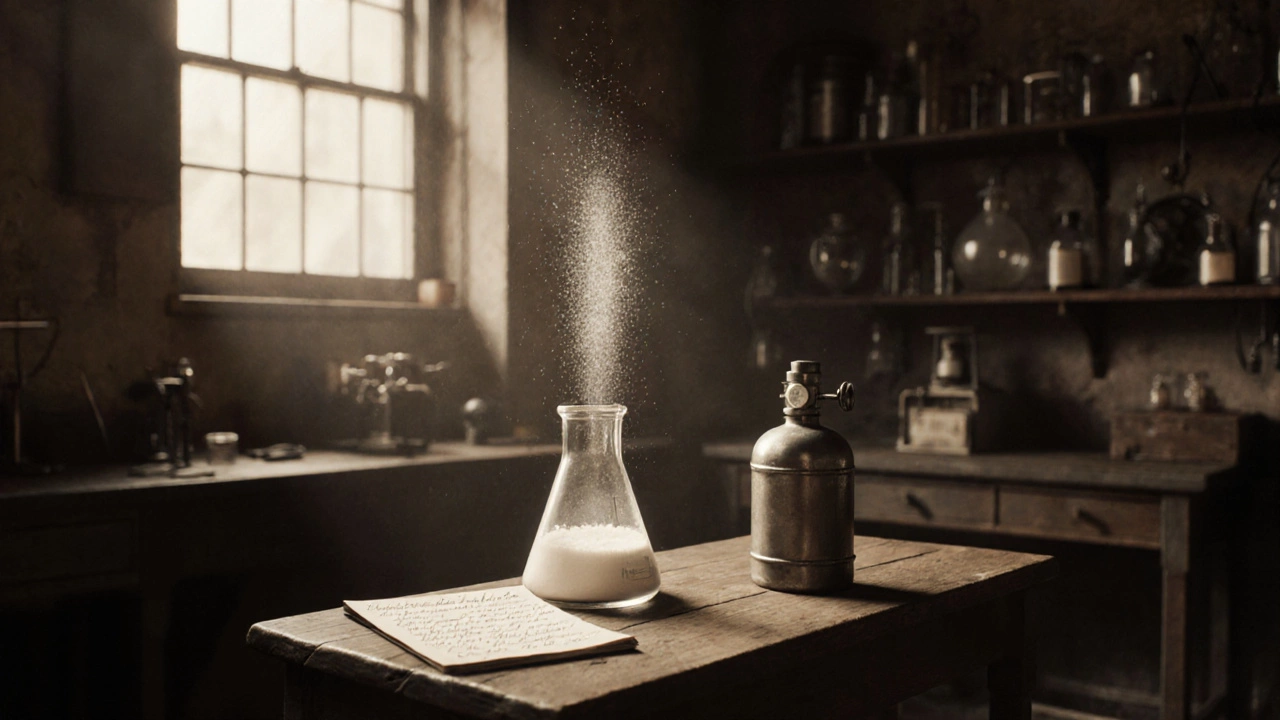Teflon Production Timeline Checker
Safety Assessment Results
Most people assume the answer is a simple year-like 2015 or 2020-but the truth is a bit messier. Teflon pans are non‑stick cookware coated with polytetrafluoroethylene (PTFE) have never been completely discontinued. What did stop is the use of a toxic chemical called perfluorooctanoic acid (PFOA) that was once part of the manufacturing process. Below we unpack the timeline, why the change matters, and what you should look for when buying today.
Key Takeaways
- Manufacture of Teflon pans is still ongoing in 2025; they were never fully stopped.
- The 2015 global phase‑out of PFOA marked the real "stop" point for the harmful ingredient, not the pans themselves.
- Modern Teflon cookware is PTFE‑based and PFOA‑free, meeting strict FDA and EU safety standards.
- Look for labels such as "PFOA‑free" or "PTFE‑only" when shopping, and follow care tips to extend lifespan.
- Alternatives like ceramic and stainless‑steel offer different performance and safety profiles.
How Teflon Cookware Came to Be
Polytetrafluoroethylene (PTFE) is the polymer that gives Teflon its slippery properties was discovered by Roy Plunkett in 1938 while he was working for DuPont the American chemical company that patented the Teflon brand. The brand name "Teflon" hit the market in 1945, but it wasn’t used for cookware until the early 1960s, when non‑stick frying pans started appearing on store shelves.
By the 1970s, Teflon pans were a kitchen staple because they let you cook with little to no oil. The secret? A thin layer of PTFE sprayed onto aluminum or stainless‑steel bases, then baked to fuse the coating.
The PFOA Turning Point
For decades, the production of PTFE involved a surfactant called perfluorooctanoic acid (PFOA) a synthetic chemical linked to health and environmental concerns. Scientific studies in the early 2000s raised alarms about PFOA persisting in water supplies and accumulating in humans.
Regulatory response was staggered:
- 2006: The European Union set a deadline for PFOA manufacturers to cut emissions to less than 0.1 ppm.
- 2011: The US Food and Drug Administration (FDA) declared PTFE-coated cookware safe if PFOA‑free began reviewing the chemical.
- 2015: An industry‑wide agreement, the PFOA Stewardship Program, officially ended major PFOA use worldwide.
So the “stop year” most people recall is 2015, when the harmful additive vanished, not when the pans themselves were halted.

Are Teflon Pans Still Made Today?
The short answer: yes. Modern Teflon cookware is produced using alternative fluoropolymers that don’t require PFOA. Companies like Tefal a leading European non‑stick brand and Calphalon an American cookware maker continue to launch new PTFE‑based lines each year.
Regulatory bodies in the US, EU, Canada and Australia all require that any PTFE cookware sold after 2015 be PFOA‑free. This means you’ll still see the Teflon name on packaging, but the underlying chemistry is safer.
Spotting Modern, Safe Teflon Cookware
When you’re in the aisle or browsing online, keep an eye out for these markers:
- PFOA‑free or PTFE‑only printed on the label.
- Manufacture date post‑2015 (often on the bottom of the pan).
- Certification logos from the EU Food Contact Materials Regulation or the FDA.
- Warranty statements guaranteeing a non‑stick coating for at least 2-5 years.
These clues confirm the pan complies with current safety standards.
Alternatives to PTFE‑Based Non‑Stick
If you’re still uneasy about PTFE, there are other options:
| Material | Non‑Stick Mechanism | Heat Tolerance | Typical Lifespan | Safety Concerns |
|---|---|---|---|---|
| PTFE (Teflon) | Polymer coating | Up to 260°C (500°F) | 3-5 years (with care) | Historically linked to PFOA; modern versions PFOA‑free |
| Ceramic | Inorganic silica‑based coating | Up to 230°C (450°F) | 2-4 years (coating can chip) | Can degrade at high heat; no fluorinated chemicals |
| Stainless Steel | Natural (no coating) | Unlimited (can sear at >300°C) | Indefinite | Requires more oil/fat for stick‑free cooking |
Each has pros and cons. PTFE still offers the easiest slip‑away cooking experience, while ceramic and stainless steel avoid polymers altogether.

Care Tips to Extend the Life of Your Teflon Pan
- Use wood, silicone, or nylon utensils - metal can scratch the coating.
- Avoid pre‑heating an empty pan; PTFE can break down above 260°C.
- Wash by hand with a soft sponge; harsh detergents and dishwasher cycles can weaken the surface.
- Store with a protective liner or separate pan to prevent contact scratches.
- If the coating starts to peel, replace the pan - ingestion of PTFE particles isn’t harmful, but it signals the pan’s performance is compromised.
Quick Checklist Before You Buy
- Confirm the product is labeled PFOA‑free (mandatory after 2015).
- Check the warranty - at least 2‑year coverage is a good sign of quality.
- Inspect the coating for uniformity; uneven spots may indicate older stock.
- Match the pan size to your stovetop - too small a pan overheats faster.
- Read user reviews for durability; many consumers mention how long the non‑stick lasts.
Frequently Asked Questions
Did manufacturers stop making Teflon pans in a specific year?
No. Production of Teflon‑coated cookware continues today. The 2015 industry agreement ended the use of PFOA, the harmful surfactant, but the pans themselves were never discontinued.
Is modern PTFE coating safe for everyday cooking?
Yes, as long as you use it within temperature limits (below 260°C) and avoid metal utensils that can scratch the surface. Regulatory bodies like the FDA and EU have cleared PFOA‑free PTFE for home use.
How can I tell if a Teflon pan is from before the 2015 phase‑out?
Older pans often lack a "PFOA‑free" label, may have a manufacturing date before 2015 stamped on the base, or come from brands that stopped updating their packaging. If in doubt, treat it as legacy cookware and replace it.
What are the environmental impacts of PTFE production?
While PTFE itself is inert, its manufacturing historically released fluorinated gases. Since the PFOA phase‑out, producers have adopted greener processes, reducing emissions by up to 90% according to EPA reports.
Are ceramic non‑stick pans a better health choice?
Ceramic coatings avoid fluorinated chemicals, which appeals to health‑concerned cooks. However, they tend to wear out faster and can lose non‑stick performance at lower temperatures than PTFE.

